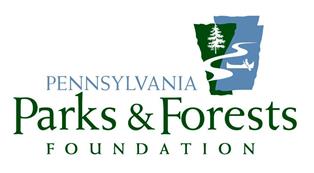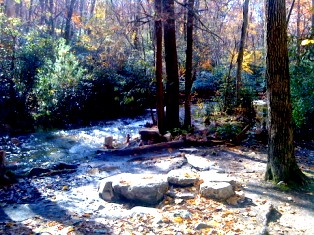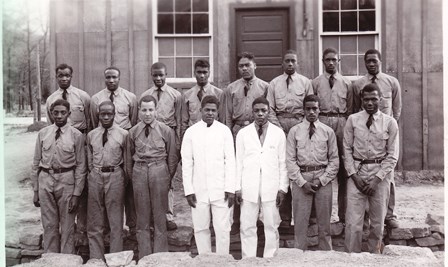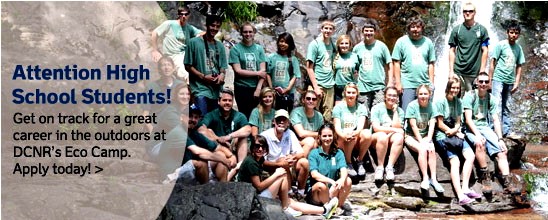|
Pennsylvania's State Parks and Forests: Looking Back to Move Ahead
Exploring Our Conservation Legacy
| |
Another Year Exploring Pennsylvania's State Parks & Forests

Every year, we at the Pennsylvania Parks & Forests Foundation like to focus on a particular theme for the year, building our newsletters and other "messages" around something we want to highlight, be it the need to play, the health benefits of an active, outdoor life or the joy of there being "something for everyone" in Pennsylvania's state parks and forests. In this first issue of Explore for another year, we introduce our theme for 2015 - "Looking Back to Move Ahead - Exploring our Conservation Legacy."
"Legacy" is a big deal for us. We know that what we do today is thanks in large part to the efforts of people who were here long before us, and that it is our (ALL of our) responsibility to make sure that we leave things just a little bit better for the people who will follow. So, since February is Black History Month, we believe it's worthwhile to check in with the contributions to conservation and volunteerism of African Americans in Pennsylvania's conservation history. And, as a reminder, we're working with the Pennsylvania Conservation Heritage Project to build a website and an archive of people - past AND present - whose contributions to the conservation of our public lands should be celebrated. Visit PAConservationHeritage.org to see the beginnings of the project and to take our survey on how you might get involved and perhaps suggest someone we may have missed.

~ Pam Metzger, Membership Coordinator
Pennsylvania Parks & Forests Foundation
Explore Pennsylvania's Parks & Forests

Penn-Roosevelt State Park
This 41-acre park in the beautiful Seven Mountains area of central Pennsylvania is paradise for those seeking a "get away from it all" place for active outdoor recreation. Park Manager Michael Dinsmore could hardly be blamed if he wanted to keep the Stone Creek Kettle area as his own personal playground! After all, the park may be small but 80,000 acres of the Rothrock State Forest surround it.
Instead, Mike enthusiastically invites everyone to take the journey into Penn-Roosevelt and sample the quiet life for a few days. The camping there is all rustic/tents only but for a little added comfort this past fall, the park constructed two 8x14 elevated platforms (complete with boat dock tie-offs to secure your tent if you wish) to get the ol' bones off the ground. The park received a donation through the Pennsylvania Parks & Forests Foundation to fund two more that should be up and ready before the end of the summer. In addition, the park's "walk in" tent sites are unlike many others in the system offering a private streamside getaway that make sound sleeping through long summer nights almost guaranteed.
 At Penn-Roosevelt, you'll find a link to the 256 boot busting kilometers of the Mid State Trail, mountain biking trails throughout the neighboring Rothrock (maintained through the efforts of the Nittany Mountain Biking Association) and enough history (see Explore Volunteerism below) and room for quiet contemplation that you won't even notice that the former lake is in drawdown at the moment awaiting dam repairs. (If you have a spare couple of million dollars, it's possible to bring the lake back a little faster than presently scheduled.) At Penn-Roosevelt, you'll find a link to the 256 boot busting kilometers of the Mid State Trail, mountain biking trails throughout the neighboring Rothrock (maintained through the efforts of the Nittany Mountain Biking Association) and enough history (see Explore Volunteerism below) and room for quiet contemplation that you won't even notice that the former lake is in drawdown at the moment awaiting dam repairs. (If you have a spare couple of million dollars, it's possible to bring the lake back a little faster than presently scheduled.)
Interested in volunteer opportunities at Penn-Roosevelt? The Friends of Greenwood Furnace (a chapter of the Foundation, from whom the picture of one of the walk-in campsites was borrowed) have a committee devoted to work at Penn-Roosevelt and would love to talk to you!
Explore Volunteerism

CCCC - The "Other" Civilian Conservation Corps
The Civilian Conservation Corps was established in 1933 as a part of Franklin D. Roosevelt's New Deal. Members of the CCC were unmarried, unemployed young men from families thrown into poverty as a result of the Great Depression. They were recruited to provide unskilled manual labor (but learned what can only be called advanced trade skills) in exchange for "three squares a day" and a small wage. In Pennsylvania, there were 114 camps including at what are now Blue Knob, Hickory Run, Laurel Hill and Promised Land State Parks.
It was an enlightened program for an only partially enlightened time. Racial segregation, especially in the South, led to the creation of racially segregated camps, sometimes referred to as the "CCCC," the Colored Civilian Conservation Corps. Nationwide, approximately 250,000 black enrollees served in the CCC. The men in the segregated camps were fed the same three meals a day and paid the same $30 a month as their white counterparts. They did the same work as men in other camps, including building improved recreation areas, creating state parks and other recreation areas, planting trees to combat deforestation, fighting forest fires, and constructing roads, bridges, dams and forest fire lookouts.
 According to John Eastlake (whose articles on the CCC appear in each issue of the Foundation's newsletter, Penn's Stewards) and his fellow CCC researchers Mike Schultz and Paul Fagley, the camp at what is now Penn-Roosevelt State Park was known as S-62 and was one of the 26 segregated camps to be found in Pennsylvania. Camp ruins, including stone fireplaces, can still be seen (and used) at the park. Another of the 26 was S-76 State Camp, near Renovo, at which this picture (click for a larger version) was taken. According to John Eastlake (whose articles on the CCC appear in each issue of the Foundation's newsletter, Penn's Stewards) and his fellow CCC researchers Mike Schultz and Paul Fagley, the camp at what is now Penn-Roosevelt State Park was known as S-62 and was one of the 26 segregated camps to be found in Pennsylvania. Camp ruins, including stone fireplaces, can still be seen (and used) at the park. Another of the 26 was S-76 State Camp, near Renovo, at which this picture (click for a larger version) was taken.
The projects done by the men in the CCC have had a lasting impact on the parks and forests in Pennsylvania. Today, the forests have recovered from deforestation caused by the logging industry, and the land continues to be enjoyed by all.
For more on the CCC and the CCCC, visit:
- The archived issues of the Foundation's newsletter, Penn's Stewards, and the articles of John Eastlake
- The comprehensive record of the CCC on DCNR's history pages (where you'll also find a terrific interactive map for locating each of the state's camps and delving into additional information on each)
- The archives of the New Deal Network of the Franklin & Eleanor Roosevelt Institute (where a 1941 document entitled "What the Civilian Conservation Corps is Doing for Colored Youth" offers a startling statistical look at the impact the CCC had on the African American community, even in its less-than-perfect segregated state)
Explore Campfire Recipe

Gourmet Salmon Pate
Backpacker magazine says this "easy prep appetizer is front-country fine but easy enough to make at your campsite." Click the photo for the recipe and a full three-course gourmet campsite delight featuring Red Gnocchi & Bacon and tiramisu. Yum! (We'll see you by the stream at Penn-Roosevelt!)

Explore Trivia

In our last (December) issue, we asked about the Mother of Pennsylvania Forestry, born on Christmas Day in 1853. She was, indeed, Mira Lloyd Dock, a pretty amazing woman (in a pretty amazing hat in the photograph most often used of her). Check out her mini-bio in our Conservation Hall of Fame on the PA Conservation Heritage website.
Congratulations to Gayle who will receive a copy of Green Chic: Saving the Earth in Style (and so perhaps may come up with a pretty amazing hat, too)!
This time around, our focus is Ralph Brock, another member of the Hall of Fame. He is widely believed to have been the first African American forester in the United States. In 1906, he and five others were the first to graduate from the Pennsylvania State Forest Academy, today known as Penn State Mont Alto. He led a distinguished career in state and private forestry, was the superintendent of the Mont Alto State Forest Nursery, and specialized in estate gardens, orchards, and landscaping.
For this issue, tell us in which state forest was Ralph Brock employed before the first academy class was formed?
Send your answer to Pam Metzger at the Foundation. All correct answers will be entered into a drawing for a copy of Changing a Bike Tire: A Guide in Pictures, our light-hearted look at a necessary skill.
Explore the Green Life

ECO Camp with the Department of Conservation & Natural Resources
Hey, kid! What are you doing this summer? Would you like to find out what it's like to be a district forester, park manager or state geologist? If you are (or know) a high school student entering at least your sophomore year next fall, ECO (Exploring Careers Outdoors) Camp might be right for you. Click the photo to check out the particulars.

And, don't forget, there's still time to register for the Private Forest Landowner's Conference sponsored in March by Penn State Extension.
Explore PPFF and our Programs

We know that 2014 is over but our photo contest gallery is not! Come visit us at the State Capitol's East Wing Rotunda all during February and see the beautiful shots that won our 2014 contest. Perhaps you'll be inspired to participate in the 2015 contest. The guidelines are available at our website, as is our PPFF Up to the Minute calendar with details on where else the showcase will be appearing in the coming months (including Pittsburgh's Penn Brewery on March 4 and the Columbia Kettle Works on March 19)!
We are gearing up as well for our annual awards banquet in May, with more about that and our honorees to come in the April issue of Explore. For now, we're actively looking for donations to that night's silent auction - the proceeds from the auction will be directed to accessible recreation projects including purchase of adaptive kayaking equipment for state park recreation programming. If you have an item you would like to donate (perhaps a basket of goodies from your business or favorite local business), get in touch with Marci Mowery at the Foundation.
Welcome to the new DCNR Secretary
Our parks and forests have a new leader! Governor Tom Wolf has named Cindy Adams Dunn to serve as the secretary of the Department of Conservation and Natural Resources. Cindy is no stranger to DCNR, having served in several leadership roles with the agency over the span of almost 20 years.
 Cindy first joined DCNR in 1996 as director of community relations and environmental education. She left the agency to serve as the executive director of Audubon Pennsylvania from 1997-2003. Returning to DCNR, she served in several leadership roles over the ensuing years, finally as deputy secretary of Conservation and Technical Services from 2007-2013, where she led DCNR's conservation landscape program and oversaw the community conservation partnerships grant program. Cindy first joined DCNR in 1996 as director of community relations and environmental education. She left the agency to serve as the executive director of Audubon Pennsylvania from 1997-2003. Returning to DCNR, she served in several leadership roles over the ensuing years, finally as deputy secretary of Conservation and Technical Services from 2007-2013, where she led DCNR's conservation landscape program and oversaw the community conservation partnerships grant program.
For the 14 months prior to being appointed as secretary by Governor Wolf, Cindy was the president and chief executive officer of PennFuture, a statewide environmental advocacy organization.
Cindy is a life-long conservationist and champion of the outdoors. As an avid outdoor recreation enthusiast, Cindy spends her free time birding, canoeing, fishing and hiking. As secretary, she'll now steward the very resources she has enjoyed throughout her life.
Explore comes to you courtesy of the Pennsylvania Parks & Forests Foundation
1845 Market Street | Suite 202 | Camp Hill, PA 17011 | 717.236.7644
 Sponsorship of this issue of Explore courtesy of PPL. Sponsorship of this issue of Explore courtesy of PPL.Content about Pennsylvania's conservation history provided through the support of a grant from the Heinz Endowments.
|
| |
|
|
|
Email Marketing By
|


|
|
|
|